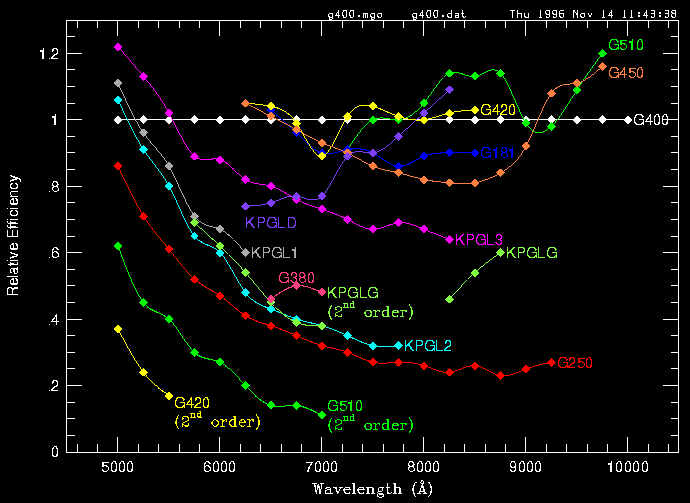Gratings for the Hydra Multiple Object Spectrograph
The gratings shown below can all be used with Hydra. The dispersions shown are those obtained when the gratings are used with the 400mm Bench Schmidt camera and the 2x4K SiTe CCD.
200 and 100 µ wide slit plates are available to put in front of the output of the fibers.
With the 400mm camera and no slit plate the images will be approximately 7 pixels wide. With 200µ and 100µ slits they will be about 4.5 and 2.5 pixels wide respectively. Thus, with (say) KPGL3 which has a dispersion of .70A/pixel at 5500A, the resolution would be .70X7=4.9A (R=1100) with a bare fiber, .70x4=2.8A (R=1900) with the 200µ slit plate and .70x2.5=1.75A (R=3000) with the 100µ slit plate. The efficiency of the system will be reduced by about 25% when the 200µ slit plates are used and by roughly 60% with the 100µ slits.
In selecting a grating, you should take into account the tabulated grating efficiencies ((grating for 4m RC spectrograph)) or those shown in the charts at the bottom of this page. These charts were made with the R/C spectrograph. For Hydra the wavelength scale should be shifted by about 9% towards the red.
The 229mm Air Schmidt camera with the 1Kx3K Loral CCD is now available a backup only. With the Air Schmidt the dispersions are 1.75X the values shown and the images are approximately 4 pixels wide. The slit plates do not improve the resolution with the Air Schmidt because of the poor images and thus cannot be used with this camera.
Gratings
GENERAL: All the gratings used in the R/C spectrograph will fit on Hydra. However, gratings 250 and 400 have been left off the list because their dispersion is too low to be useful. Grating 420 is not included because it is redundant with KPGLF and less efficient.
Dispersions will be half the values shown when the gratings are used in second order.
| First Order at blaze wavelegth with 400mm camera: For Air Schmidt (retired) multiply dispersion by 1.75X, coverage by 1.31X | |||||
| Grating # | Lines/mm | Blaze (see note #4) |
Dispersion (A/mm) |
Coverage (4096 piixels) |
Comments |
| 510 | 300 | 10000 A | 1.24 A/pixel | See note #1 | |
| 181 | 316 | 7500 A | 1.18 A/pixel | See note #1 | LOW THROUGHPUT |
| KPGL2 | 316 | 4400 A | 1.19 A/pixel | See note #1 | |
| KPGL3 | 527 | 5500 A | .70 A/pixel | ~3800A | |
| KPGL1 | 632 | 4200 A | .59 A/pixel | ~2400A | See note #2 |
| KPGLF | 632 | 8200 A | .57 A/pixel | ~2300A | |
| 450 | 632 | 11000 A | .56 A/pixel | ~2200A | |
| KPGLD | 790 | 8500 A | .45 A/pixel | ~1800A | |
| KPGLG | 860 | 11000 A | .42 A/pixel | ~1700A | |
| 380 | 1200 | 8000 A | .27 A/pixel | ~1100A | See note #3 |
| ECHELLE | 316 | 56120 A | (wavelegth/ 105,000) /pixel |
~.038 x Wavelegth |
See note #5 |
Sometimes it is necessary to use an order-separating filter. Available filters are shown here. Don't use a filter unless you must, since they cause a slight loss even at their best wavelengths and can cause suprious reflections.
Looking for spectra taken with the comparison lamps?
NOTE #1 Care must be taken when using gratings 510, 181 and KPGL2. They have too much wavelength coverage for the CCD. Second order contamination limits the coverage to less than the full width of the chip and a blocking filter is normally required.
For example, if KPGL2 is used with a central wavelength of 6000A, coverage from 4000-8000A can be obtained but a filter blocking wavelengths below 4000A will be needed. Wavelengths beyond 8000A will be seen on the CCD but will be strongly contaminated by second order blue light.
Grating 181 as currently used in the Hydra spectrograph has very low throughput, and should not be used until further notice. (KAO 1/25/06)
NOTE #2 KPGL1 should always be used with a blocking filter, EVEN in first order. Tests done by P. Massey and K. Olsen in March 2005 demonstrated that a few percent of the light in the red appears in the blue at half the wavelength (not to be confused with second order diffraction, which goes the other way). The problem was likely introduced by the machine that ruled the grating. None of the other gratings have been found to have this problem.
NOTE #3 Grating 380 is not very efficient in second order and produces very bad ghost reflections at some wavelengths.
NOTE #4 Blaze wavelength is shown in "Littrow", i.e. normal incidence. This is how they are used in the spectrograph and is approximately the peak wavelength.
NOTE #5 See the echelle mode documentation for more information about how to use the echelle grating.
Relative Efficiency of R/C Spectrograph Gratings
(Wavelegths for Hydra = scale x 1.09)
Last updated
19apr2005 -kao
Updated on June 29, 2021, 7:52 am

